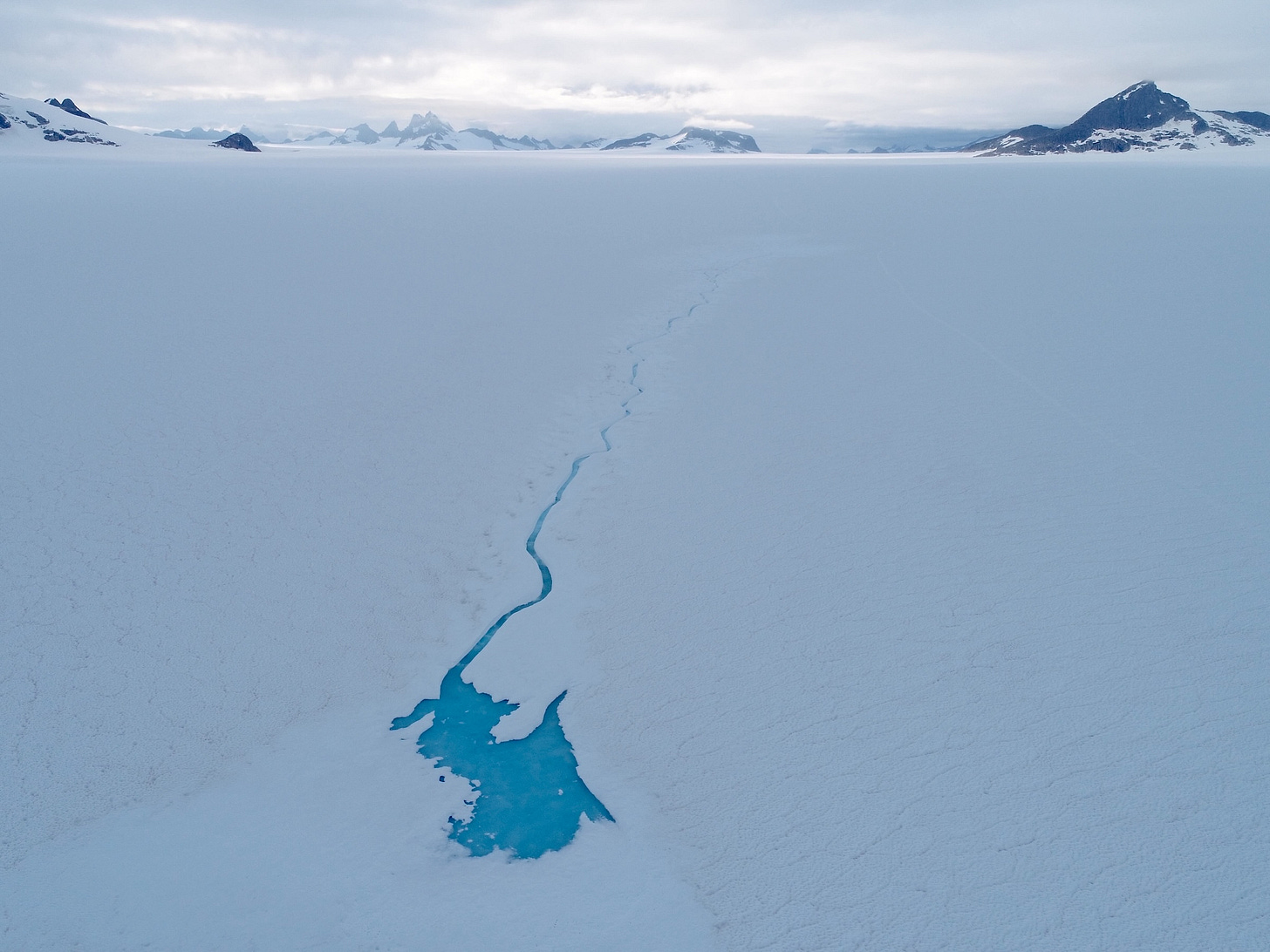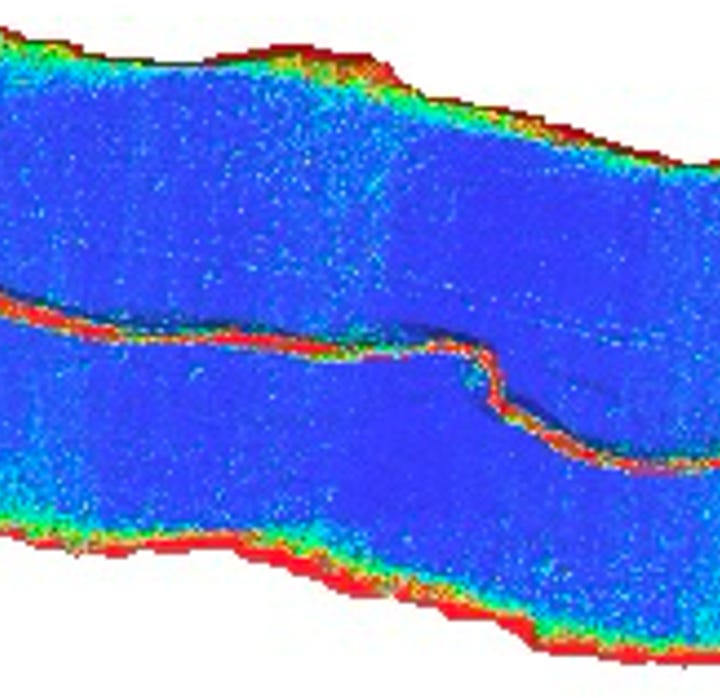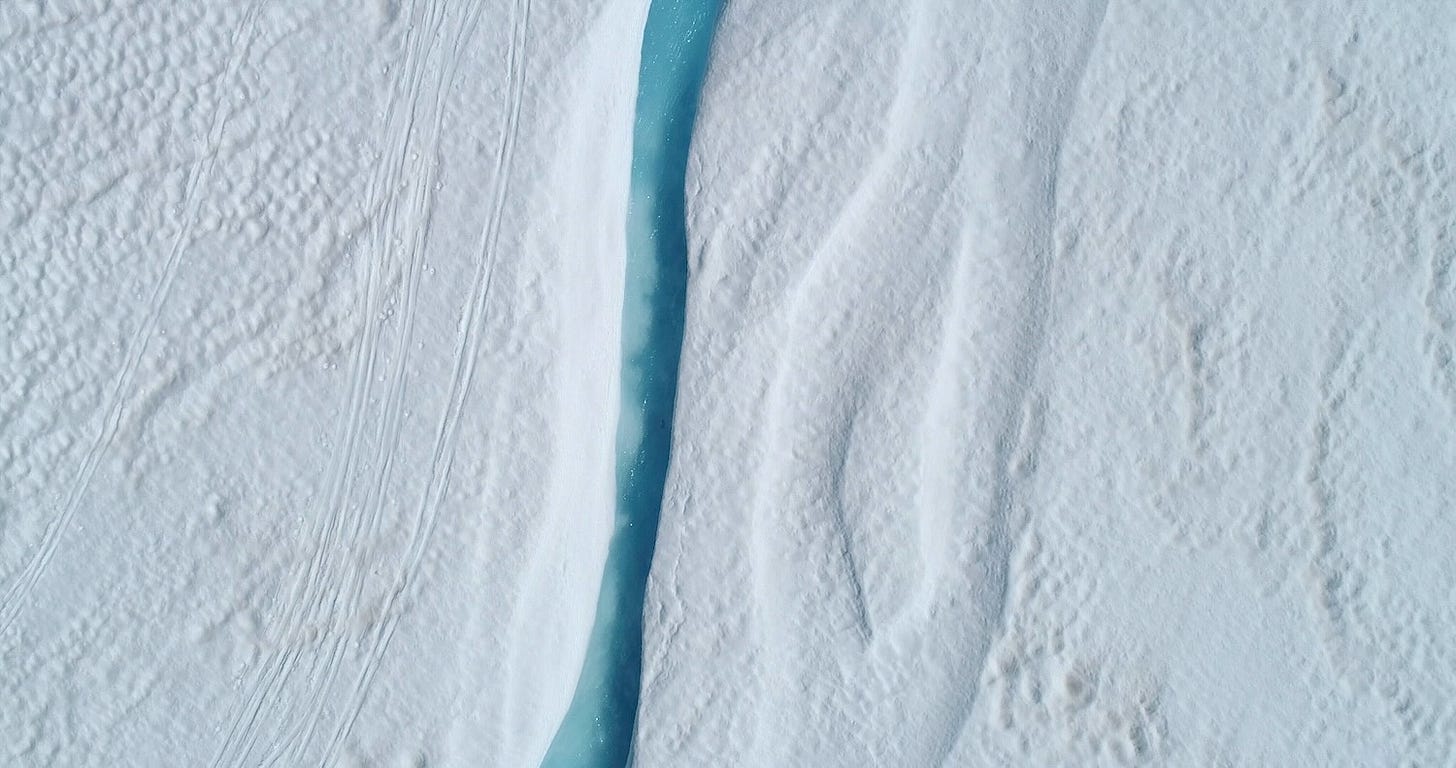Process Pending: paths defined by uncertainty
when the best-defined path is the one with the lowest confidence & dec/jan reading recap
Horrifying, absurd, and expected, the Trump administration has done things like a) briefly freeze all NIH funding, b) stop passports issued to trans folks, and c) urged the expansion of oil and gas This is affecting foreign aid programs, scientific research in the US, and many federally funded programs focused on equity, inclusivity, diversity, and justice.
Here’s a helpful call sheet to voice your support for USAID & foreign aid. You can also support the Urban Ocean Lab, which is archiving datasets related to coastal resilience
Over and over again, I return to these two images:
The top image, in grey and blue, is a transient supraglacial hydrologic system on the Juneau Icefield’s Taku Glacier. That is, it shows a stream that flows into a slush pond on the top of a glacier. Sometimes it is there, sometimes not. We think it formed for the first time1 in 2021, which means Taku is changing – probably experiencing more melt higher up (no surprise)2.
The top image is not just a photograph of the stream, but a screen shot of the top down view of a 3D surface “reconstructed” from many, many photographs taken with a UAV3. By using many images, we can get really a high resolution (cm) 3D model of the stream. By returning to the stream and mapping it again, we can see how the stream changes over time4.
The top shows the whole stream-pond system in color, as we see it with our eyes and in the photographs. The bottom image tells me how confident the software5 is about its reconstruction, that is, about the fidelity of the surface, about how well it has rebuilt reality. Blue is super confident; red is deeply unsure of itself. In general, the software’s confidence comes from having lots of overlapping pictures from different points of view of the same spot on the ground.
We can zoom in on one piece of this bottom image
and start to notice a few things.
One, the software isn’t sure what’s happening at the edges – that’s just telling me I flew the UAV along the stream, and didn’t get many pictures of the edges from different angles. That’s fine, I don’t care what’s happening at the margins.
Two, the software is pretty sure of itself when it comes to the snowy glacier surface (see the blue parts, and compare. There’s enough ski tracks, snow cups, shadows – that is, contrast – for the software to decide definitively that one piece of the surface is different from another. Plus, the UAV had GPS on it. So it had an idea to start where all the images should go, a bit like if I gave you a jigsaw puzzle where each piece was marked with what quadrant it went in.
And finally, three: the software has no idea what is going on with the surface of the actual stream: it is almost all red or neon green. Now this makes sense: the stream is flowing. It is mobile, dynamic, and anything but temporally fixed. The software, which is trying to reconstruct a surface, cannot. Through its material properties and state of motion, liquid water inherently resists this kind of technological observation.
Normally you would throw out the locations where the confidence is this low. But we are not interested in reconstructing the surface of the stream, we are interested in the path of the stream. And for that, we follow the course of lowest confidence, picking from all possible futures the one that contains the least information.

In the last few months, we moved into our house and spent time traveling to/from the states. Reading has been haphazard, and I found it difficult to make much progress on Solenoid. But I tore through Madame Bovary, and read the first half of the book twice. I loved his choice of structure at the beginning – Flaubert’s use of “us” – and the scene between the apothecary and the priest at the end. Flaubert uses beauty – gorgeous descriptions of the moments of life that feel like paintings – to create tension by pausing time. Three or four sentences, then an interjection of character.
The stream, which makes this part of Rouen into a kind of sordid little Venice, flowed past below hjm, yellow, violet, or blue, between its bridges and its railings. Workmen squatting on the bank, washed their arms in the water. On poles projecting from beyond the tops of attics, hanks of cotton dried in the air. Across from him, beyond the rooftops , extended the great , pure sky, with the red sun going down out there. How good it must be out there!
and
Through the slits in the wood, the sun cast over the flagstones long, narrow stripes that broke at the angles of the furniture and trembled on the ceiling. On the table, flies were walking up the used glasses and buzzing as they drowned at the bottom, in the dregs of cider. The daylight that came down the chimney turned the soot on the fire back to velvet, touched with blue the cold cinders. Between the window and the hearth, Emma was sewing; she wore no fichu, on her bare shoulders one could see little drops of sweat.
Books I started
Madam Bovary by Gustave Flaubert (trans. Lydia Davis)
Piranesi by Susanna Clarke
Howl’s Moving Castle by Diana Wynne Jones
Chess Story by Stefan Zweig
Clara Schumann: The Artist and the Woman by Nancy Reich
The Inheritance Trilogy by N.K. Jemisin (audio, re-listen)
Playground by Richard Powers
Books I continued, with incredible slowness
Solenoid by Mircea Cărtărescu
Books I finished
Matrescence by Lucy Jones
Madam Bovary by Gustave Flaubert (trans. Lydia Davis)
Piranesi by Susanna Clarke
Howl’s Moving Castle by Diana Wynne Jones
Chess Story by Stefan Zweig
Clara Schuman: The Artist and the Woman by Nancy Reich6
The Inheritance Trilogy by N.K. Jemisin (audio, re-listen)
Books I bought
Dylan Thomas: The Collected Letters (edited by Paul Ferris)
The Earth Transformed: An Untold History by Peter Frankopan
Midnight's Children by Salman Rushdie
The Master and His Emissary: The Divided Brain and the Making of the Western World by Ian McGilchrist
Chess Story by Stefan Zweig
Mostly I listened to approximately 9 million hours of the Empire podcast, recommended by Anjali (ty). I particularly loved the episodes on the Koh-i-Noor diamond (eps 8-11), the overview of the Ottoman Empire, incl. Suleiman the Magnificent (eps 25&26), Evliya Çelebi (ep 32), Lady Mary (ep 33), and the episodes on Babur (ep 204-207).
Because of the book on Schumann, a conversation I had this week about Frederik and Rachel Ruysch, the relationship many emperors had with their children as catalogued by Empire (see above), and Ukichiro and Fujiko Nakaya as always, thinking about fathers and daughters and art-science collaborations as they emerge across generations.
Trying, with effort, not to, “morose, gnawed by regrets, railing at heaven, envying all the world, … shut [my]self away at the age of forty-five, disgusted with men”,
Elizabeth
What does “for the first time” mean for a glacial system that has appeared and disappeared, ever changing over the history of the planet? idk, but let’s say here that what i mean by this is the first time in the last 75 years.
Davies, B., McNabb, R., Bendle, J. et al. Accelerating glacier volume loss on Juneau Icefield driven by hypsometry and melt-accelerating feedbacks. Nat Commun 15, 5099 (2024). https://doi.org/10.1038/s41467-024-49269-y
a DJI phantom pro 4
This work was part of a set of workshops Hannah and I designed for the Junaeu Icefield Research Program to teach artistic and scientific concepts and methods through each other in 2023
here, I used agisoft metashape
Nancy Reich, it turns out, is the grandmother of my second cousins. My mom did not know this when she bought this book! I stole it from her shelf years ago! I only found this out when my cousin Julia saw it on my shelf in Brooklyn and told me about it.






